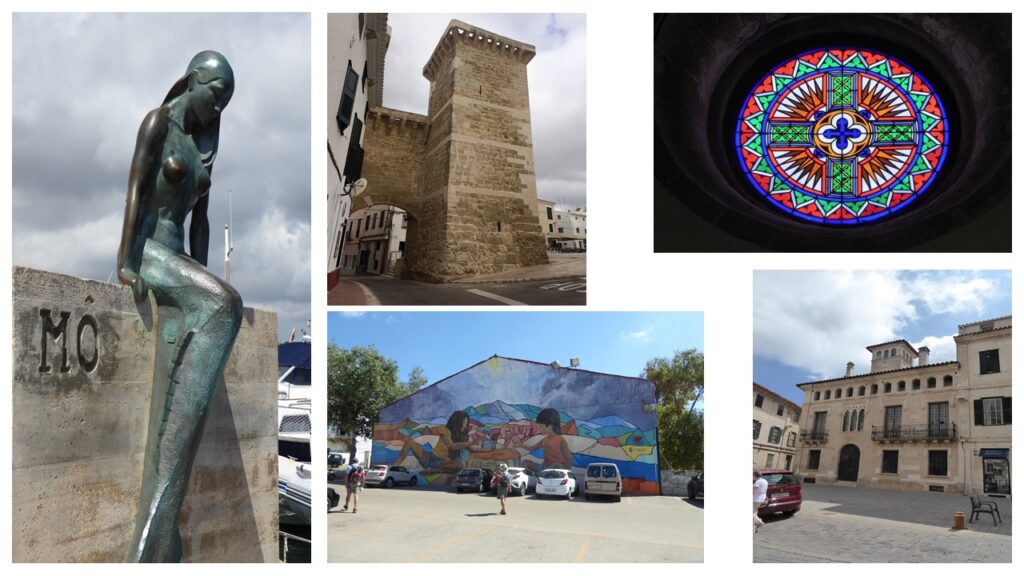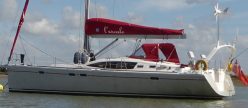Thursday 20 – Tuesday 25 August
The following morning, Aurelie had obviously given up any hope of quality rest, and was away very early on their long passage Westwards. They arrived safely a few days later. Meanwhile, we headed out to sea to make water, finding it lumpy and uncomfortable outside the harbour. We managed to set the staysail once we were able to turn South, parallel with the coastline, and anchored off the Illa de l’Aire lighthouse, that stands on a tiny island off the Southwestern tip of Menorca. The water was incredibly clear, so we were able to see that we were trying to set the anchor onto rocks, never a good idea, but we held steady long enough to make some water, at least until the machine broke – again. Poor Skipper spent most of the afternoon trying to fix it – again, and made a temporary repair, but we’d made so little water we hoped to stay overnight. However, a quick snorkel inspection revealed that the anchor was snagged on a rock, and couldn’t be trusted to hold if the wind changed direction overnight, which is always all too likely, so we headed back to Mahón. We didn’t even try to sail, as it was still lumpy in a strongish Northerly, and we were very tired. Back in Cala Taulera, we managed to find a comfortable spot well away from the Black Marlin.
On Friday, 21 August, we took ourselves back up the harbour to the city, for an extended look around, some shopping and a pleasant lunch from a menu del día, the daily set menu which are good value, at a restaurant on the quayside. The island has been occupied variously by Spanish, French and English. Also known as Maó, the city was designated the capital of Menorca during the British domination of the island during the 18th Century, because its extensive harbour and deep water offers much better protection for the Fleet, stationed at this strategic point in the Mediterranean, than that of Ciutadella on the opposite side of the island. The naval history of the area is apparent, from the military buildings painted ‘English Red’, a distinctive deep shade very different from the whites and muted pastels of local facades, to the classic lines of the Naval Command Centre on an island opposite the city.

the oldest gateway; a church window; street art;
attractive architecture
There are many examples of ornate cast iron railings decorating balconies, while a large number of residential properties have shutters and doors in a uniform dark green, which gives a pleasing harmony to a mix of styles and paint colours. Interesting architecture of many eras is around every corner in this lovely city, from the only remaining piece of the original city wall, the 14th Century Sant Roc portal, to the elegant Art Nouveau façade of Casa Mercadel, owned by a noble Menorcan family and built on the site of an ancient castle overlooking the harbour, to the attractive exterior of the ancient dwelling on Plaça del Princep that faces you as you walk along the side of the Esglesia del Carme. The cloisters of this ancient church are an unusual venue for a highly browsable market, offering everything from local food specialities like cheese and salami-like sausage to Xoriguer gin (introduced by the British to keep the sailors’ whistles whetted), clothing, jewellery and the unique Avarca sandals worn by both genders and all ages.
Saturday morning saw us away early for another attempt to make water. We found a likely spot just a little beyond the lighthouse of the other day, and tucked in to Cala Biniancolla for a successful afternoon’s production, in spite of the comings and goings of locals enjoying their weekend on the water. We tucked back into Cala Taulera once again, for a quiet Sunday followed by laundry detail for Mate on Monday – by hand, with as little as possible of our lovely ‘home made’ water. Waving hello to a British-flagged small motor boat that came in near to us, it soon became apparent that their anchor was dragging, of which fact they were duly warned. They relocated a little further away, but on lifting their anchor to head off, we noticed that they’d managed to hook the anchor of a 52-foot Beneteau yacht, that they seemed unaware of towing halfway around the anchorage. We dashed over in our dinghy to help, and were able to restore calm and order to a potentially damaging and expensive situation: the skipper of the yacht was not aboard when this situation arose, and the boat was heading towards an equally large catamaran, also without any crew in evidence. Fortunately the yacht skipper returned during the debacle, and allowed us to manage the untangling and safe replacement of his anchor, whereupon Cheeky – yes, really – sloped off somewhat shamefaced.
As always, we were watched by an avid audience, including a French 40’ Dufour, with whom we chatted briefly on our way home. Her skipper jokingly asked if he could call on us should he need assistance the following day.
During the morning of Tuesday 25th, we noticed we’d drifted too close to the shallows again, and reset our anchor once more in deeper water. By strange coincidence, while the French man’s wife was in town on the Tuesday, his anchor dragged and he ended up where we’d touched bottom when we first arrived here. In trying to regain control, the line of his secondary anchor became caught around his prop (are you sensing a pattern here?) and once again it was l’arret to the rescue, along with a kind Spanish gentleman in another dinghy. Skipper was invited aboard to render assistance, while Mate towed the yacht – one hand steering and the other clamped to his bow line – away from the shallows to safety. Later he expressed his gratitude by the gift of a bottle of French fizz – how kind! We exchanged boat cards, and have heard they arrived safely into Corsica.
